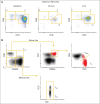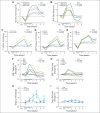Redistribution, hyperproliferation, activation of natural killer cells and CD8 T cells, and cytokine production during first-in-human clinical trial of recombinant human interleukin-15 in patients with cancer
- PMID: 25403209
- PMCID: PMC4268254
- DOI: 10.1200/JCO.2014.57.3329
Redistribution, hyperproliferation, activation of natural killer cells and CD8 T cells, and cytokine production during first-in-human clinical trial of recombinant human interleukin-15 in patients with cancer
Abstract
Purpose: Interleukin-15 (IL-15) has significant potential in cancer immunotherapy as an activator of antitumor CD8 T and natural killer (NK) cells. The primary objectives of this trial were to determine safety, adverse event profile, dose-limiting toxicity, and maximum-tolerated dose of recombinant human IL-15 (rhIL-15) administered as a daily intravenous bolus infusion for 12 consecutive days in patients with metastatic malignancy.
Patients and methods: We performed a first in-human trial of Escherichia coli-produced rhIL-15. Bolus infusions of 3.0, 1.0, and 0.3 μg/kg per day of IL-15 were administered for 12 consecutive days to patients with metastatic malignant melanoma or metastatic renal cell cancer.
Results: Flow cytometry of peripheral blood lymphocytes revealed dramatic efflux of NK and memory CD8 T cells from the circulating blood within minutes of IL-15 administration, followed by influx and hyperproliferation yielding 10-fold expansions of NK cells that ultimately returned to baseline. Up to 50-fold increases of serum levels of multiple inflammatory cytokines were observed. Dose-limiting toxicities observed in patients receiving 3.0 and 1.0 μg/kg per day were grade 3 hypotension, thrombocytopenia, and elevations of ALT and AST, resulting in 0.3 μg/kg per day being determined the maximum-tolerated dose. Indications of activity included clearance of lung lesions in two patients.
Conclusion: IL-15 could be safely administered to patients with metastatic malignancy. IL-15 administration markedly altered homeostasis of lymphocyte subsets in blood, with NK cells and γδ cells most dramatically affected, followed by CD8 memory T cells. To reduce toxicity and increase efficacy, alternative dosing strategies have been initiated, including continuous intravenous infusions and subcutaneous IL-15 administration.
Trial registration: ClinicalTrials.gov NCT01021059.
© 2014 by American Society of Clinical Oncology.
Conflict of interest statement
Authors' disclosures of potential conflicts of interest are found in the article online at
Figures









References
-
- Rosenberg SA, Yang JC, Topalian SL, et al. Treatment of 283 consecutive patients with metastatic melanoma or renal cell cancer using high-dose bolus interleukin-2. JAMA. 1994;271:907–913. - PubMed
-
- Maloy KJ, Powrie F. Fueling regulation: IL-2 keeps CD4+ Treg cells fit. Nat Immunol. 2005;6:1071–1072. - PubMed
Publication types
MeSH terms
Substances
Associated data
Grants and funding
LinkOut - more resources
Full Text Sources
Other Literature Sources
Medical
Research Materials

